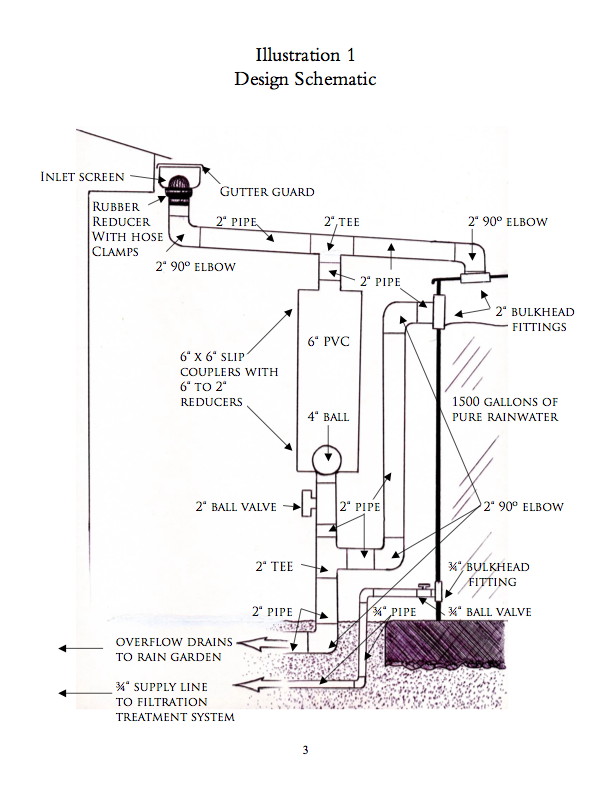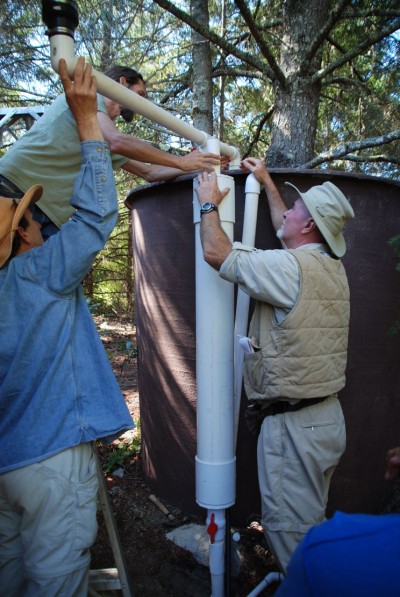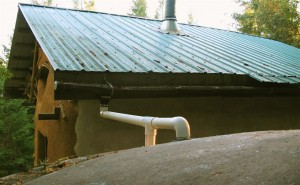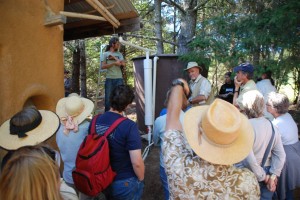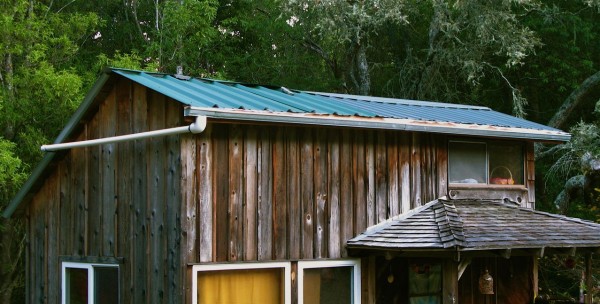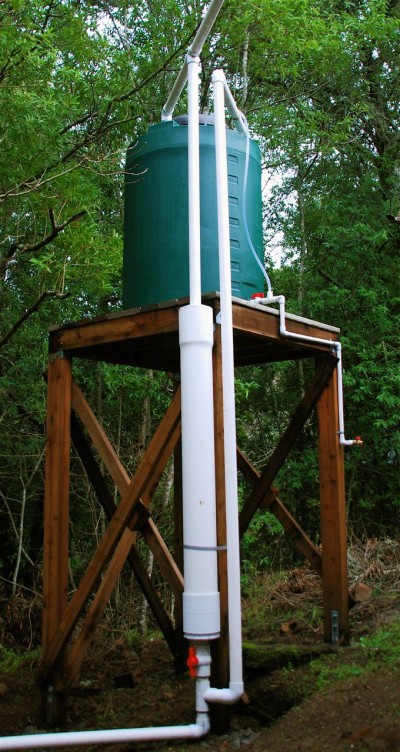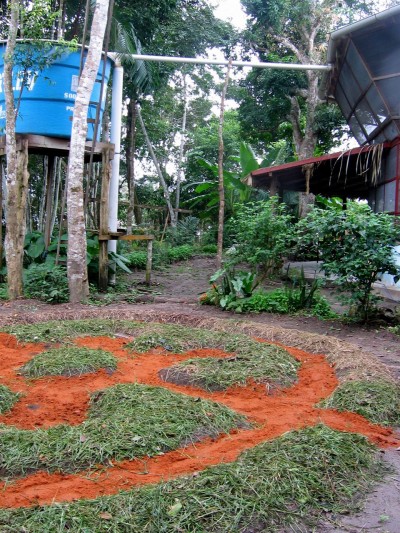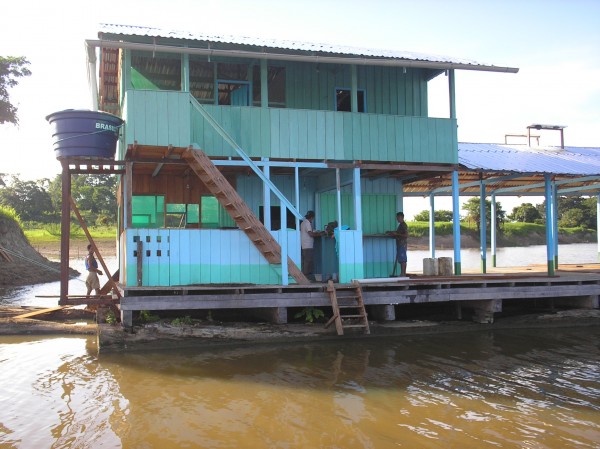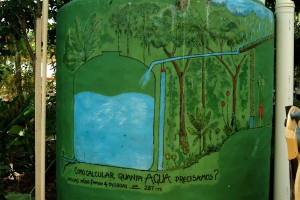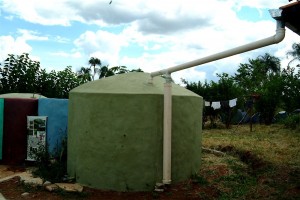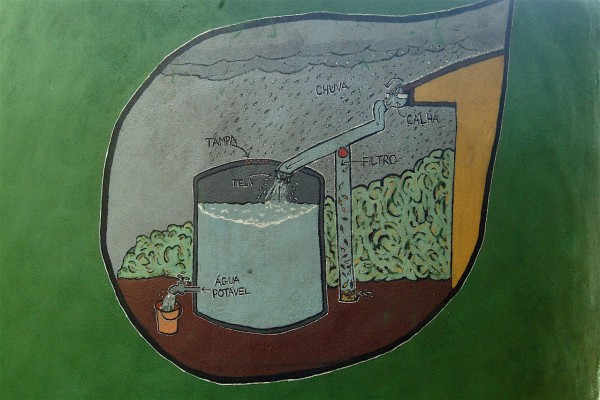Roof Water Harvesting for a Low-Impact Water Supply
By Brock Dolman and Kate Lundquist
Photographs by Jim Coleman and Brock Dolman
Illustrations by Jim Coleman
We would like to thank the Compton Foundation, the Dean Witter Foundation, and the Panta Rhea Foundation for their generous support of this project.
OAEC’s WATER Institute was established to offer positive responses to the crisis of increasingly degraded water quality and diminishing water quantity. We promote a holistic and multidisciplinary understanding of healthy watersheds through our four interrelated program areas — Watershed Advocacy, Training, Education, and Research.
The Occidental Arts and Ecology Center (OAEC) is a nonprofit education and organizing center and organic farm in Northern California’s Sonoma County. Since 1994, OAEC has explored, educated about, and implemented innovative and practical approaches to the pressing environmental and economic challenges of our day.
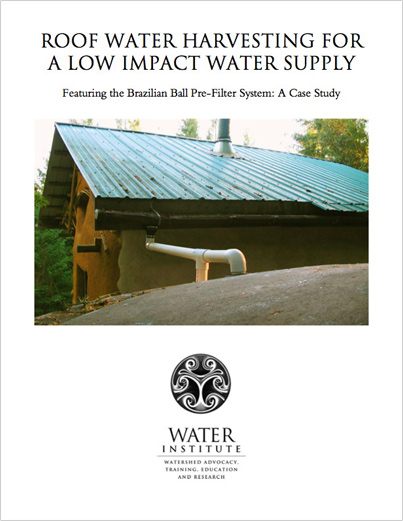
INTRODUCTION
Fresh water is a precious and limited resource that nourishes innumerable life forms. As population pressures increase, the majority of communities around the world are facing decreasing supplies of fresh water in general, and many lack access to potable water at all. This lack of access impacts human health around the globe, as many die from waterborne diseases and related illnesses every year. For those who do have access to fresh water through private wells, springs or municipal systems, water quality can be compromised by naturally occurring heavy metals and imbalanced mineral load,s or increasingly by toxic chemicals that contaminate groundwater supplies. Concerns have been raised over the potential impact that chlorine and chloramines found in municipally treated water have on human health as well.
There are others that are being impacted as well. As the demand for fresh water increases, this precious resource is being diverted, dammed, and extracted to the degree that a large number of watersheds, and the myriad species that rely upon the water supplied by them, are being put under strain and are being listed as impaired, threatened or endangered.
In those communities where access to fresh water is limited and watershed health is of concern, one viable “low-tech” solution is to build a roof water harvesting system. By creating the means to store water on site, using the existing rainfall as the source and infiltrating the grey water and remaining run-off, one can eliminate the need to draw from precious ground water supplies and avoid the high costs (economic and environmental) of hooking into centralized conveyance and treatment systems. Humans benefit from having a self-sufficient, clean water supply that additionally provides fire protection and costs far less than bottled water. The ecosystem receives benefits from the reduced erosion, flooding, and pollution caused by run-off and the reduction of demand on groundwater supplies.
At the WATER Institute, we are very interested in exploring these kinds of strategies and, through demonstration and education, work to inspire others to consider doing the same. With the help of a group of students, we designed and built a few roof water catchment systems to learn firsthand what is required to build these systems and how well they work.
The following report details the components and illustrates the highlights of two variations on one particular design we have dubbed the Brazilian Ball Pre-Filter System. WATER Institute staff learned of this particular design while participating in the 8th International Permaculture Convergence that happened in May of 2007 in several locales across Brazil. The images and descriptions towards the end of this report detail a few of many systems that inspired our design. We use the term “low-impact” to describe this system because it models the design concepts of Low Impact Development which is a “storm water management approach with a basic principle that is modeled after nature: manage rainfall at the source using uniformly distributed decentralized micro-scale controls…and mimic a site’s predevelopment hydrology by using design techniques that infiltrate, filter, store, evaporate, and detain runoff close to its source. The result is a hydrologically functional landscape that generates less surface runoff, less pollution, less erosion, and less overall damage to lakes, streams, and coastal waters.” (Low Impact Development Inc.). This design is one of many styles of catchment systems that exist around the world, and we encourage you to explore the resources listed at the end of this report to learn more.
SYSTEM 1
Below is a photo of a functioning roofwater harvesting system that utilizes the Brazilian Ball Pre-Filter (as illustrated in illustration 1). This design uses an existing 1500-gallon fiberglass tank. There are many other tank options to consider (see resources). For specific details and explanation of how this pre-filter works, please refer to Illustrations 1 and 2. At this site, the ground level at the bottom of the tank happens to sit at a higher elevation than the ground level of the building itself. This small change in elevation is enough to create adequate, albeit low, water pressure for a simple kitchenette-style sink and allows us to install the tank directly on the ground. This is ideal, as fewer resources are needed for this system, such as tower materials or electric pressure tanks.
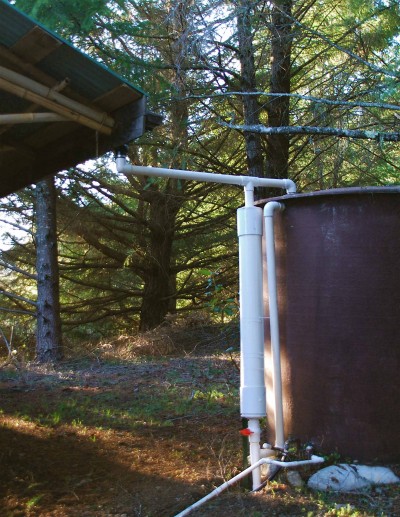
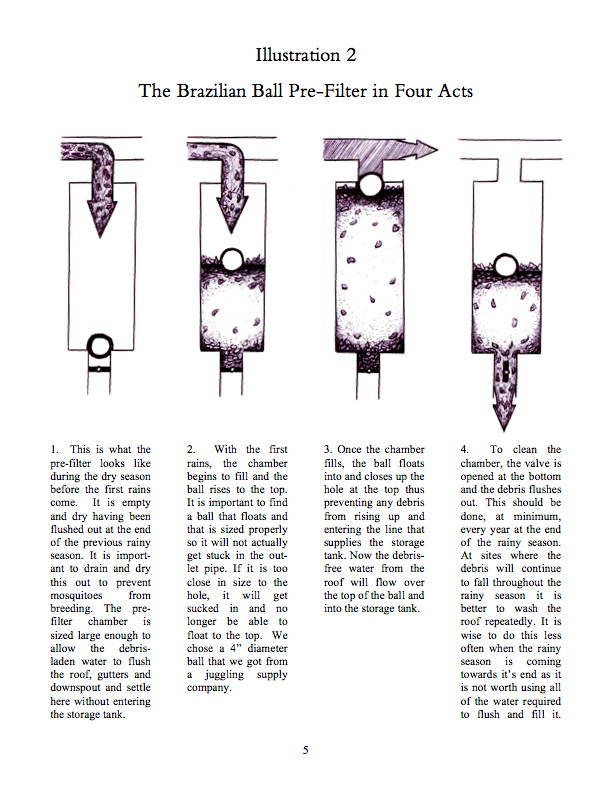
Below is a photo of OAEC staff working with students of our August 2007 Roof Water Catchment course to connect the pre-filter to the roof and tank lines. Note that we have chosen not to use PVC cement to hold the pre-filter, roof connector, and overflow components together. Because the water is not under pressure, these components stay together well and do not leak. This allows for easy disassembly of the system for maintenance, if needed. Since these components are costly and have a large ecological footprint, it is nice to have the option to reuse the components in the future if this system is decommissioned or moved (handy for renters!). Finally, we can avoid exposing ourselves unnecessarily to the toxic fumes and residues left by PVC cement. PVC pipe was not our first choice for plumbing components as the process of manufacture and subsequent leaching from pipes into water can be toxic. A better alternative, that was not available to us at the time, is High Density Polyethylene (HDPE). These large diameter HDPE pipe and fittings tend to cost more than PVC of this size, though it is less toxic over the long run to the health of the manufacturers and end users.
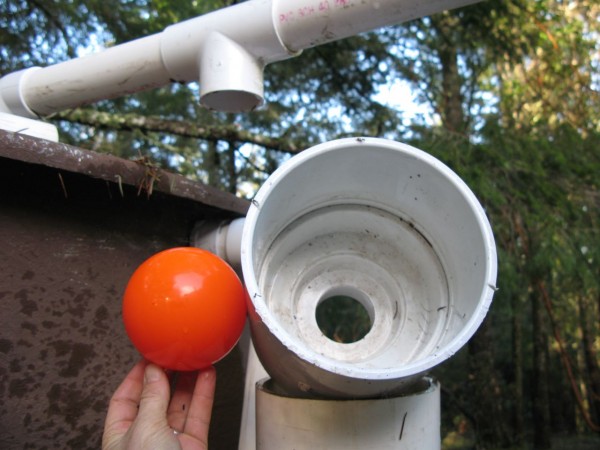
The image below shows a close up of the downspout connection detail and the gutter with its wire screen covering. A standard rubber reducer with hose clamps was used to connect the rectangular downspout fitting to a 2” PVC nipple. This slip nipple had to be cemented into the 90-degree elbow, as the fittings would not stay together otherwise. This is the one exception we made to our cement-free design (a threaded nipple would not require cement). The gutter screen shown here is one part of many steps in the pre-filtration and maintenance strategy used in this system.
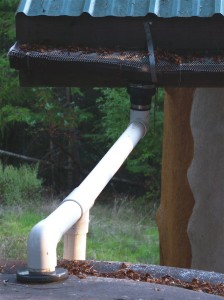
Notice the Douglas fir trees in the background of previous photos. These trees drop needles, branches and other debris that can clog and potentially contaminate the system. To avoid this, we implement a regimen that embodies the Permaculture principle of “planned redundancy.” Every year before both the fire and the rainy seasons begin we sweep the roof clean and remove any accumulated debris from the bottom of the gutter. To prevent introduction of debris during the rainy season we have installed wire screen (or gutter guard) over the top of the gutter. We chose to use a metal gutter guard because it allows us to firmly secure it by bending it over the outside edge of the gutter. Some gutter guards are made of plastic and are designed to sit just inside the top edge of the gutter. These tend to collapse more easily allowing debris to get into the gutter. An additional wire screen has been installed in the bottom of the gutter at the outlet leading to the downspout to catch any debris that has made it past the top screen. All of these strategies act as pre-filters to the main Brazilian Ball pre-filter that is highlighted in this system. In potable systems it is worth the effort to employ multiple strategies for preventing organic matter from entering the tank because it reduces the need for cleaning the tank and the hassle of unclogging any fixtures downstream of the system.
To the right we have a photo of the roof, the associated gutter (or “eaves trough” for those who don’t like the idea of drinking out of the “gutter”) and plumbing to tank. The painted steel roofing is one of the better choices for harvesting roof water because it does not contribute contaminants to the water (see resources on page 24 for places to obtain more information on roofing choices). The skirt of the woodstove flashing (or roof jack) seen in the upper portion of this photo is made of lead, a heavy metal known to be toxic to humans. To avoid introducing lead to our drinking water, we have installed a piece of roofing over the gutter section that lies below this portion of the roof. This ensures that all rainwater falling on the lead skirt will run over the gutter, onto the ground and not enter into the drinking water tank. Notice that this system is collecting rain from only one side of the entire roof. Due to a 60-inch annual rainfall and the size of the one side of the roof (275 sq. ft.), we are easily able to fill the existing 1500-gallon tank to meet the annual drinking water needs of the users.
RAINWATER CALCULATOR
A = catchment area of building (square footage of roof)
R = annual inches of rainfall
G = total amount of collected rainwater
A x R x 600 gallons / 1000 = G
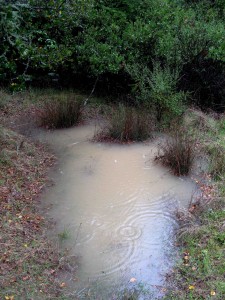
We use the rainwater calculator formula (above) to calculate what amount of rainfall the roof water catchment system will capture and store. So, in this case, we have 275 sq. ft. roof (or catchment area) times 60 (our average annual rainfall) times 600 gallons divided by 1,000, and we get 9,900 gallons of water that we can potentially collect and store. Because we are using an existing tank that holds only 1,500 gallons, we will not be able to store all of the rain that falls on this roof. The overflow will run into our rain garden instead. In fact, this size roof only takes ten inches of rain to fill the 1,500-gallon tank. For more info, visit www.mycarpentry.com/rain-harvesting-calculator.html.
Roof water harvesting systems need to be designed to handle overflow when the tank gets full. Rather than let this precious water run away, we have plumbed the tank overflow pipe and Brazilian Ball Pre-Filter to empty into a rain garden down the slope. A rain garden, in this case, is an excavated depression with a downhill berm. The shape allows for the excess roof run-off to form a temporary pool of water during the storm event. After the storm, the water slowly infiltrates into the soil, helping to recharge shallow groundwater, reduce run-off and associated erosion, and create some habitat for wildlife and native plants.
One goal of the WATER Institute is to help educate and inspire individuals to implement water-saving ideas in their own homes and communities. We were heartened to see the level of interest shown by the 32 attendees of our sold-out Roof Water Harvesting class held in August 2007. The more we as citizens and communities choose to implement these water-saving strategies, the more we contribute to water security and the restoration and protection of water-stressed ecosystems.
SYSTEM 2
Here we have a different building that utilizes a similar roof water harvesting system. Here, too, the roof is metal, and only one side (100 sq. ft.) is being used to feed the system. In this case, the low elevation of the gutter in the rear of the building precluded us from hooking it up because the tank would have to be placed so low that there would not be adequate pressure in this gravity-fed system to supply a sink at waist height. This system uses a different strategy for connecting the PVC pipe to the downspout hook-up on the screened metal gutter. A 3” PVC elbow is held in place with plumbing tape that is screwed into the fascia. This elbow has a reducer where it joins with the 2” PVC pipe that carries the water to the tank. The amount of water that comes off of this smaller roof surface is still plenty to fill the 200-gallon tank and supply the drinking water needs of the user. Based on the formula mentioned in the description of system 1, can you figure out how much water this system yields in a 60” annual rainfall year?
In this system, the site where we wanted to locate the tank slopes downward behind the building. To ensure adequate water pressure, we built a tower to raise the height of the tank. In areas that are seismically active, it is important to secure the tank to the platform.
In this close-up up you can see the ½” clear tubing we are using as a water level gauge. This is helpful in a system where the tank is harder to reach, as you can see the water level without having to climb up the tower. It is also helpful in systems with smaller storage tanks, as you may have to monitor levels more often and adjust use accordingly. Please note that this kind of gauge works best if it is not exposed to direct sunlight. The sunlight can cause algae to grow in the tube and thus affect the water quality.

A close-up of what the water level looks like in the gauge. The height of this line corresponds with the height of the water level in the tank.
BRAZILIAN INSPIRATION
This photo depicts a system located deep in the interior of the Amazon at Instituto Permacultura da Amazonia’s (IPA) jungle center in Boa Vista do Ramos. IPA is a project of the non-profit Permacultura America Latina (PAL) founded by Ali Sharif. As stated on PAL’s website, “PAL supports grassroots sustainable development initiatives and low impact economic practices in poor and indigenous communities throughout Latin America. PAL manages and provides technical and financial support to affiliated permaculture schools and demonstration centers in Brazil, Ecuador, Peru and Guatemala. IPA was formed in 1997 in Manaus, Brazil, as the result of an initiative backed by the United Nations Development Program and the Ministry of Agriculture…and was created to establish a sustainable farm and initiate a complementary permaculture education program.” Notice that the tank is elevated on a tower to optimize gravity fed water pressure. This is made possible by the high elevation of the two-story roof.
This house boat (called a flutuante) is floating on 3 massive logs (each 5 feet in diameter). It has a solar system for electricity, a roofwater catchment system for water, an aquaculture system attached to the sides and a store on board. The flutuante will be used as a floating Permaculture classroom for the community in and around Boa Vista do Ramos.
Here’s a painting of a typical roofwater harvesting system with the Brazilian Ball Pre-Filter found amongst Brazilian Permaculture practitioners. This educational illustration is painted directly on the Ferro cement tank. This particular system is located at Instituto Permacultura do Cerrado (IPEC) in Pirenopolis (in central Brazil near Brasilia). As noted on PAL’s website, “IPEC was established in 1999 to create the second permaculture reference center planned for Brazil. Since breaking ground on this fifty-acre parcel, a panorama of natural building techniques, renewable energies, food production, and a well-established level of community participation have made IPEC a unique example of sustainable development in South America.”
This is a full view of the same kind of roofwater system, also located at IPEC. Notice that the bottom of the pre-filter has only a cap and is supported by loose bricks. To flush the system, one simply pulls away the brick and pulls of the cap. While this is a reasonable and inexpensive strategy, we chose to integrate the outflow of the pre-filter and the tank overflow into a single pipe leading to a rain garden to make use of the excess water. The tank is hand-made of Ferro cement, a common technique used throughout the world (see Art Ludwig’s Water Storage: Tanks, Cisterns, Aquifers and Ponds © 2005 for detailed description and plans).
Here is yet another Ferro cement tank with an artistic rendering of a typical roofwater catchment system at IPEC. We at The WATER Institute staff are inspired by the creative designs and use of tanks for educating the community about roofwater catchment. We are grateful for all the amazing work being done in Brazil by the Permaculture community and their willingness to share their amazing ideas and strategies with all who are interested.
CONCLUSION
We hope this booklet has inspired you to learn more and to consider building a roof water system of your own. Before you get started, there are things to consider. We lay out these considerations with the hope that you will further research and use the resources we have provided to make your own informed decisions and that the information presented here will empower you to work with officials to get these kinds of systems approved.
- Existing Rainwater Codes – First and foremost, you will want to find out if there are any existing policies or ordinances in your city, county and or state that regulate the use of rainwater. In many cases, if you are serviced by municipal water supply, they are going to want you to use a backflow prevention device, especially if you are plumbing your rainwater into the same system. These devices cost in the hundreds of dollars to install and require annual inspections by qualified inspectors (see the On Tap Magazine listed in the resources to learn more about cross-connection contamination). Some municipalities require you to install a backflow prevention device even if you only have stand-alone rain barrels attached to your gutters that will be used for irrigation only. We find this requirement does not give much incentive to use rainwater and we hope that other jurisdictions do not follow their example. We encourage you to look at the examples we have given under Rainwater Catchment Policy Resources at the end of this booklet to learn more about the progressive policies that are being enacted in water-scarce areas around the world and work with your local representative to create similar policies in your own city or county.
- Building Safely – As with any building project, it is important to take steps to ensure that your design is safe. Water is VERY heavy (8.35 pounds/gallon) and it is worthwhile to pay professionals to review your plans and even install your system if you do not have the skills to design and build it safely yourself. Certain designs require approval from the Building Department. Check to see what requirements your city or county have regarding tank construction (i.e. ferrocement) or installation of prefabricated tanks (especially if you are placing it on a platform or tower and live in a seismically active area). Not all building departments are familiar with ferrocement tank design and we encourage you to take this opportunity to educate your building department officials about how these tanks work and offer examples of those that are currently being approved in many counties across the US.
- To Drink or Not To Drink – It is important to think about what you will be using this rainwater for. If you are going to want to drink this water, you will want to test it to determine what is in it and at what level. Rainwater is comparable in quality to any privately sourced water (springs and wells). Both often both test positive for general coliforms. These are different than fecal coliform or E. coli (both of which can cause harm). The presence of general coliforms indicates that the water has come into contact with organic matter (plant or animal) and does not guarantee that the water will cause illness. However, the drinking water standard requires that NO coliform be present. While some drink untreated rainwater, it is up to each individual to decide whether s/he wants to take this risk. You can eliminate general coliforms through various means (boiling the water for one minute, chlorinating, using an Ultra-Violet purification system, etc.) and we recommend that you consider doing so if you have any concerns, are ill or have compromised immunity. There are several resources online that talk about what coliform bacteria are, how to treat for them, the pros and cons of treatment regimens, and why these coliforms are perceived as a risk.
